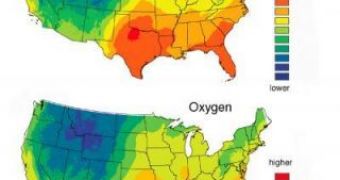No alibi for killers, no unknown origins for the victims: a new crime-fighting tool analyze human hair for revealing location, helping police to follow the past movements of criminal suspects or murder victims.
"You are what you eat and drink - and that is recorded in your hair," said lead researcher Thure Cerling, a distinguished professor of geology and geophysics, and of biology at the University of Utah.
"We have found significant variations in hydrogen and oxygen isotopes in hair and water that relate to where a person lives in the United States. Police are already using this to reconstruct the possible origins of unidentified murder victims," said co-author Jim Ehleringer, a distinguished professor of biology at the University of Utah.
The new research published in the journal Proceedings of the National Academy of Sciences is based on the analysis of the stable isotopes (those that do not break down radioactively). Ehleringer had developed a method used by the U.S. Drug Enforcement Administration to see where cocaine and heroin were produced, relying on local percentages in carbon, nitrogen, oxygen and hydrogen isotopes absorbed into coca and poppy plants during their growth from soil and water. The analysis of the hydrogen and oxygen isotopes can even detect on counterfeit $100 bills where the cotton of the paper was grown, based on the water used by the living plant.
The new technique focus on stable isotopes of hydrogen (rare hydrogen-2 and common hydrogen-1) and oxygen (rare oxygen-18 and common oxygen-16) which are incorporated by hair from water and food. The isotope ratios in the food tend to be the same across U.S. Because food tend to come all over from the same areas.
But 85 % of the variation in isotope levels in a person's hair is due to the values in local drinking water. Just one hair can tell where a person has dwelt in the last weeks to years, depending on the length of the hair. The team even made maps revealing ratio variations of hydrogen and oxygen isotopes in hair, connected to various US regions.
"You can tell the difference between Utah and Texas," said Ehleringer. "But you may not be able to distinguish between Chicago and Kansas City," said Cerling.
The maps were made based on hair and water samples in 65 cities in 18 states across US. The variation of the isotopes is connected to clime. Clouds moving from the ocean onto the continent first shed water with oxygen-18 and hydrogen-2 because it is heavier, thus the water near the coast and lower farther inland should be rich in these isotopes. But other factors, like cloud temperatures, seasons or the water evaporating from soil and plants, are also involved.
That's why oxygen-18 and hydrogen-2 amounts in waters plummet moving inland from the West Coast (with cold winter storms) while staying high in the inland areas from the Gulf and southern Atlantic coasts (with warmer clouds).
"Drinking water from any area has an isotope signature that is incorporated into growing hair. That signature is not complicated by other beverages because a significant fraction of beer, soft drinks and milk is local in its origin," said Ehleringer.
The lowest levels of hydrogen-2 and oxygen-18 were encountered in northern and western Montana, north-central Idaho and northwest Wyoming, because of the cold and remoteness from the Pacific Ocean. The highest levels of hydrogen-2 and oxygen-18 were encountered in southern Oklahoma, north-central Texas, Florida, south Georgia and southern South Carolina, because of the abundant summer rainfall, and high lake water evaporation, leaving behind more of heavier isotopes in drinking water.
The method could have forensic application. The alibi of a person who moved from Beijing to Salt Lake City was proven when hair grown during three months before the move revealed high levels of oxygen-18 and hydrogen-2, typical for Beijing drinking water. But this can have more than forensic applications.
"Anthropologists and archaeologists may use the method to analyze ancient hair samples to reveal where Native Americans migrated or show a Mormon settler's movement from Missouri to Utah," said Ehleringer.
"Analyzing preserved bison hair may reveal more about their migration patterns when they were abundant," said Cerling.
Archaeologists could see in the hair of ancient people or animals what they ate, if they consumed seafood or land-based aliments. Also social class is revealed by a diet rich (or not) in meat protein or plant material.
"Because diabetics drink a lot of water, the proportions of oxygen in their hair from water and food would be different than in non-diabetics," said Cerling.
"Hair also might record isotope changes due to worsening symptoms of a dietary disease," said Ehleringer.

 14 DAY TRIAL //
14 DAY TRIAL //